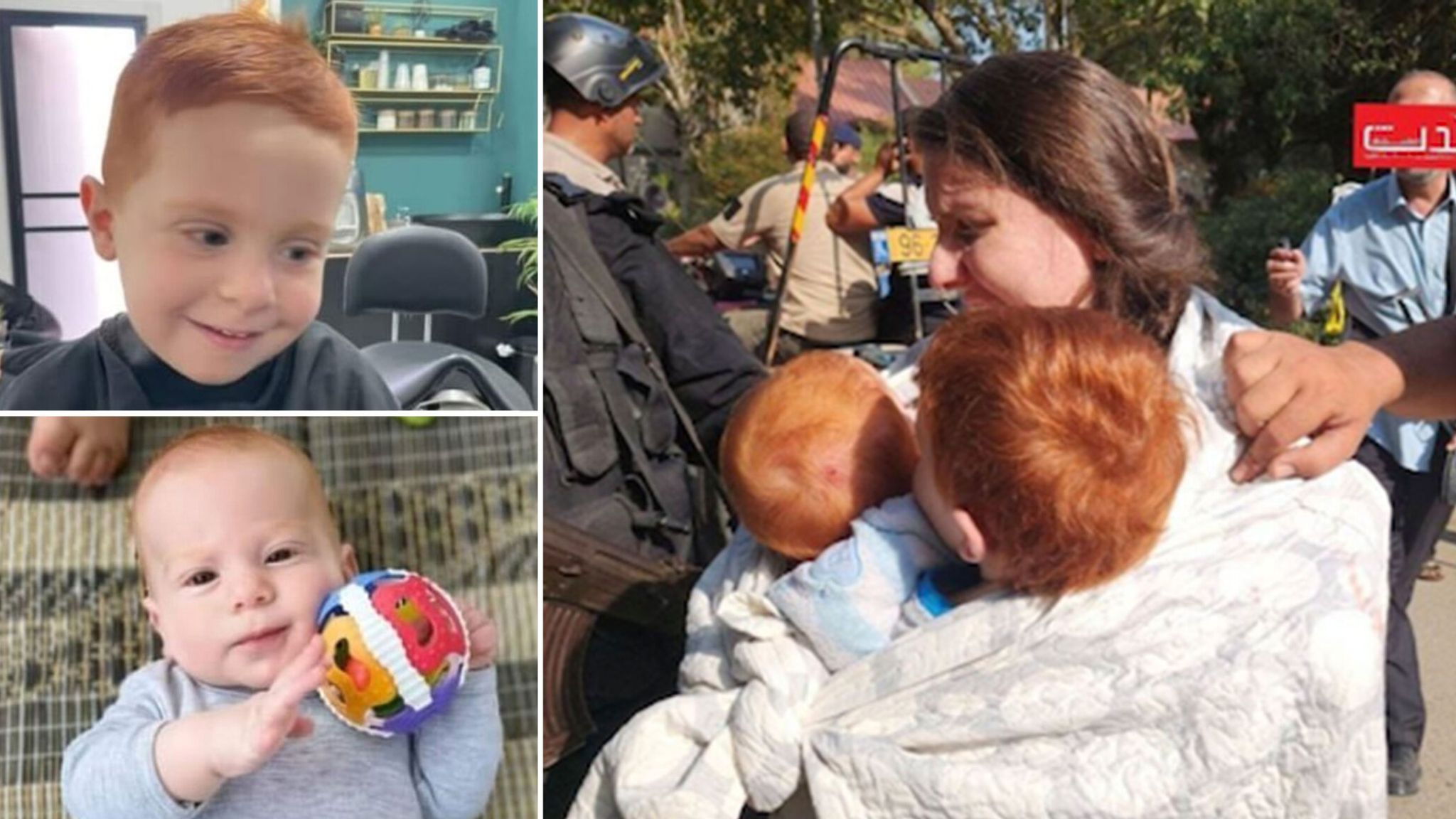Yarden, Shiri, Ariel, and Kfir: Lives Stolen by Violence.4085
On the morning of October 7, 2023, the peaceful routines of Nir Oz, a quiet kibbutz in southern Israel, were violently shattered. Yarden and Shiri Bibas, along with their two children, Ariel and Kfir, began what seemed like an ordinary day. The sun rose over the community, children were getting ready for school, and families went about their daily lives. But that ordinary morning would become the start of an unimaginable nightmare.

Without warning, Palestinian militants launched a sudden and brutal attack on Nir Oz. Chaos erupted. In the confusion, Yarden Bibas was separated from his wife and children. He was abducted alone, leaving Shiri and the children behind. In the days that followed, Shiri’s parents—who also lived on the kibbutz—were discovered murdered, victims of the same violent assault. For the Bibas family, the nightmare had just begun. For Israel, the attack became a symbol of the vulnerability of communities living under constant threat.

Shiri and her children were reportedly transferred to another armed group within Gaza: the Mujahideen Brigades of the Palestinian Mujahideen Movement. The uncertainty surrounding their fate plunged their friends, neighbors, and the broader Israeli public into fear and grief. Israel expressed public concern, trying to locate and negotiate for the safe return of the hostages. The world watched, holding its breath, as days turned into weeks with little news.

Months passed with scarce information. On February 19, 2024, the Israeli Defense Forces (IDF) released a video showing Shiri and the children alive, seemingly unharmed just days after the abduction. The footage, filmed in southern Gaza, offered a glimmer of hope—a fleeting proof that the family was still together. Yet, that hope was fragile. In late 2023, Hamas had publicly claimed that Shiri and her children had died during Israeli bombings in Gaza, spreading misinformation that concealed the truth and prolonged the suffering of those awaiting news.

Yarden endured months in captivity before his release on February 1, 2025. His return was bittersweet. Though alive, he carried the unbearable weight of knowing his wife and children were still missing. The relief of freedom was overshadowed by fear, uncertainty, and grief. His story became emblematic of the anguish faced by hostages and their families—moments of survival juxtaposed with the torment of losing loved ones.

On February 18, 2025, Hamas announced it would release the bodies of Shiri and the children. At first glance, this seemed like a step toward closure. But the revelation concealed an even darker truth. Just days later, on February 21, Israeli officials confirmed the worst fears: Ariel and Kfir had not died in bombings, as Hamas had claimed. Instead, they had been brutally murdered in November 2023—strangled to death and mutilated by their captors. The cruelty inflicted upon these innocent children was almost unimaginable, a horrifying testament to human brutality.

Shiri’s fate was equally tragic. She had also been killed in captivity, leaving Yarden as the sole survivor of a family destroyed by violence. The deliberate concealment and manipulation of information by Hamas had prolonged his suffering, extending the torment of uncertainty for over a year.

The return of the bodies brought profound grief and outrage. The community mourned the loss of Shiri, Ariel, and Kfir, whose lives had been stolen violently and prematurely. Neighbors remembered Ariel and Kfir as bright, lively children full of laughter and curiosity. Friends recalled Shiri as a devoted mother whose love for her family was boundless. Yarden, though free, carried the invisible scars of witnessing and surviving unimaginable trauma.
The story of the Bibas family is one of unbearable loss, a stark reminder of the human cost of conflict. It is also a story of endurance. Yarden’s survival is a testament to human resilience, yet it is tempered by profound sorrow and the weight of memory. His life after release is forever defined by the absence of his beloved wife and children, their laughter silenced and their futures stolen.

For the residents of Nir Oz and beyond, the Bibas family became more than a tragedy—they became a symbol. A symbol of the fragility of life in a region marked by tension, and of the desperate hope that even amid violence, the truth will eventually be revealed. The legacy of Ariel, Kfir, and Shiri is one of remembrance, a call to acknowledge not only the horrors of war but the enduring responsibility to protect the innocent.

While the horror of their deaths cannot be undone, telling their story is crucial. It highlights the indiscriminate cruelty of violence, the agony of those left behind, and the moral imperative to seek justice. Their lives, though cut tragically short, demand that the world remembers them—not just as victims, but as human beings whose potential and joy were violently stolen.

The Bibas children, in their innocence, remind us of what is at stake whenever conflict overtakes ordinary lives. Ariel and Kfir were not soldiers, militants, or political figures—they were children, full of life and potential, whose only crime was being in the wrong place at the wrong time. Shiri’s devotion as a mother was ordinary, yet extraordinary in the face of such danger. Yarden’s courage and survival underscore the resilience of the human spirit, even when confronted with unimaginable loss.

In the wake of their deaths, communities rallied to mourn, remember, and honor the Bibas family. Public tributes, memorials, and stories shared by neighbors kept their memory alive. The tragedy sparked reflection on the human cost of political and military conflicts, emphasizing the importance of safeguarding innocent lives and exposing the truth even when it is uncomfortable or horrifying.

Ultimately, the story of the Bibas family is a somber testament to the fragility of life and the enduring impact of violence. It is a call to empathy, remembrance, and justice. It reminds us that behind every news headline, every statistic, there are real people, real families, and real suffering. Yarden, though scarred by grief, carries the memory of Shiri, Ariel, and Kfir, ensuring that their story—and the injustice done to them—will never be forgotten.

Their tragedy is both a warning and a plea: a warning of the consequences of unchecked violence, and a plea to protect those who cannot protect themselves. Through remembering their lives, the community honors the humanity of Shiri, Ariel, and Kfir—and ensures that their lives, though tragically short, will continue to resonate, teaching lessons of courage, love, and the devastating cost of conflict.

The Bibas family will forever remain etched in memory: a mother’s love, two children’s innocence, and a father’s survival amid horror. Their story is a stark reminder that even amid the horrors of the world, human compassion, remembrance, and truth remain our most vital legacies.
A Morning of Laughter Turned to Tragedy: Honoring the Lives of Bebe, Elsie, and Alice.4107

The classroom was alive with music, laughter, and the innocent energy that only children can bring. Little girls twirled and spun to the beat of Taylor Swift’s “Shake It Off,” their hair bouncing, ribbons flying, and shoes tapping against the floor. Each movement was a celebration of life, a small universe of joy contained within the walls of the room. Teachers watched with fond smiles, clapping along, joining the children in their happiness. It was a scene of pure, unfiltered delight, a morning that promised nothing but sunshine and smiles.

Among the children were three bright lights who shone with particular brilliance. Bebe King, just six years old, radiated joy wherever she went. Her laughter was contagious, a melody that lifted spirits in seconds. She loved sunshine, playing outside, and dreaming big, always with her older sister Genie by her side. Genie often described Bebe as a “little sunshine,” a child whose laughter could warm even the coldest hearts.

Elsie Dot Stancombe, seven years old, was the soul of the classroom. She had a way of noticing when someone was sad and would instantly find a way to make them smile. Her caring nature extended to her friends, teachers, and even the younger children in the school. Elsie had a spark in her eyes that seemed to promise that she would grow up to make the world a better place, one small act of kindness at a time.

Alice da Silva Aguiar, nine, carried herself with a grace unusual for someone her age. She had dreams that stretched far beyond her years, imagining worlds where creativity, empathy, and courage shaped the lives of those around her. She was kind, patient, and fiercely intelligent, always ready to help others and share her insights. Alice’s teachers often spoke of her potential, marveling at the maturity and empathy she displayed daily.
Then, in a moment, everything changed.

A man entered the classroom, and the atmosphere shifted from music and laughter to shock and terror. The sound of the knife cutting through the air was accompanied by screams, panic, and confusion. Children froze, some crying, some trying to hide. Teachers instinctively tried to shield their students, placing themselves in harm’s way, their voices pleading for calm amidst the chaos.
The scene was one of unimaginable horror. Ten people were injured in those moments, bodies scattered across the room, the innocence of the morning shattered irreparably. Among them, three little girls would not survive: Bebe King, Elsie Dot Stancombe, and Alice da Silva Aguiar.

Bebe’s sister Genie escaped, but the trauma she carries will be with her forever. She remembers Bebe’s laugh, the way her little fingers would curl around hers when they held hands, and the way her sister’s eyes sparkled when she danced. Genie’s memories are filled with light that was extinguished too soon, a presence that will always linger in her heart.
Elsie Dot Stancombe’s absence left a silence in the classroom that could never be filled. Her classmates remembered her smile, the gentle encouragement she gave to everyone, and the laughter that could turn a frown upside down. Teachers and friends alike struggled to reconcile the bright, caring girl they knew with the void left behind. Her life, though brief, was a testament to compassion, empathy, and joy.

Alice da Silva Aguiar’s death was felt not only in the classroom but across the wider community. Her dreams, ambitions, and intelligence had only begun to blossom. Teachers recalled her thoughtful questions, the books she loved, and the gentle way she approached every task. Alice was already demonstrating the leadership and kindness that would have carried her far in life. Her potential was immense, yet the world would never see it fully realized.
The immediate aftermath was a blur of sirens, frantic calls, and tearful parents rushing to the scene. Emergency responders worked tirelessly to tend to the injured, to comfort the terrified, and to restore order amidst the chaos. But no amount of heroism could reverse the loss of those three precious children. The classrooms, hallways, and playgrounds that had once been filled with laughter now echoed with grief and shock.

Families were thrown into unimaginable pain. Parents, siblings, and friends struggled to comprehend how a normal morning could end in such tragedy. Each of the girls left behind stories, dreams, and a unique presence that could never be replaced. Friends shared memories of Bebe’s bright laughter, Elsie’s acts of kindness, and Alice’s graceful intelligence. In classrooms and homes, their absence was felt like a physical weight, a reminder of the fragility of life.
The wider community came together in mourning. Vigils were held, memorials established, and support poured in from people near and far. Yet, amid the grief, there was also a determination to remember the children not for the way they died but for the way they lived. Stories of their laughter, their generosity, and their passions were shared endlessly, keeping their spirits alive in the hearts of everyone who knew them or heard of their lives.

Bebe’s love of sunshine and joy became a symbol for her community, a reminder that even in the face of darkness, brightness can endure. Elsie’s caring nature inspired initiatives in schools to encourage kindness and empathy, turning her memory into a living legacy that could continue to impact others. Alice’s dreams, though unfulfilled, became a beacon for other children, a reminder to pursue one’s ambitions with courage and grace.
Genie, Bebe’s sister, became a quiet emblem of resilience. Carrying the memory of her sister, she vowed to honor Bebe’s life by embracing joy, spreading laughter, and cherishing every moment. Families of the other girls worked to create scholarships, art programs, and community projects in memory of Elsie and Alice, ensuring that their lives continued to influence the world even in absence.

The tragedy also sparked a broader conversation about safety, mental health, and awareness in schools. Educators and policymakers grappled with how to protect children, prevent such violence, and provide support for those affected. While the pain of loss could never be fully mitigated, efforts were made to create environments where children could grow, play, and learn safely, honoring the memory of those who were lost.
Bebe, Elsie, and Alice were not defined by their deaths. They were celebrated for their laughter, their kindness, and the love they shared with the world. Their stories were retold in classrooms, at family gatherings, and in the hearts of those who knew them, a reminder that even the briefest lives can leave indelible marks. Their spirits continued to inspire courage, empathy, and joy in those who carried their memory forward.

In the years that followed, memorials for the three girls became spaces of reflection and hope. Families, teachers, and students shared stories of the girls’ unique personalities, their small but impactful actions, and the joy they brought to everyday life. Through these acts of remembrance, Bebe, Elsie, and Alice’s presence remained tangible, a reminder that love and kindness endure even after loss.
Though their lives were tragically cut short, the legacies of Bebe King, Elsie Dot Stancombe, and Alice da Silva Aguiar live on. They are remembered not for the horror that took them but for the light they brought into the lives of everyone they touched. In laughter, in art, in music, and in acts of kindness, their spirits continue to shine, inspiring generations to come.

Their story reminds us that life is precious, fragile, and infinitely valuable. It teaches that even in the darkest moments, the light of love, joy, and compassion can prevail. Through memory, action, and shared stories, the lives of these young girls continue to matter, proving that even in tragedy, hope and humanity endure.
Bebe, Elsie, and Alice were more than victims of violence. They were children full of potential, light, and dreams. And though the world lost them too soon, the mark they left behind — laughter, kindness, grace — continues to ripple outward, touching lives and reminding us all of the extraordinary impact one life, however brief, can have.





